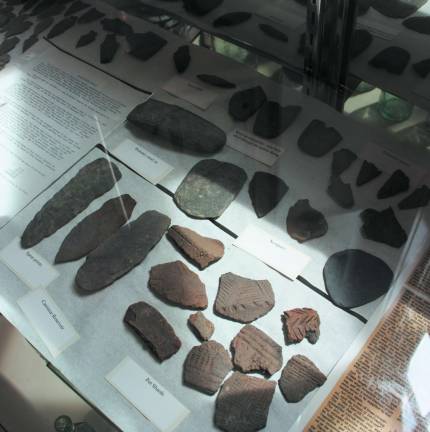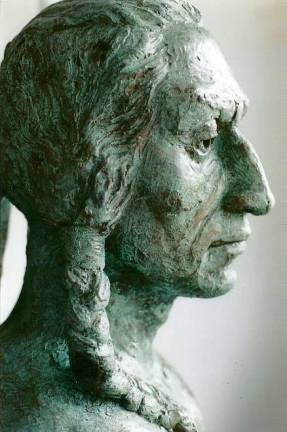By Ginny Raue
The explorers
In 1524, Lenni-Lenapes paddled their canoes out to welcome Giovanni Da Verrazano as he sailed into what is now Lower New York Bay. Verrazano later described the Lenapes as “most beautiful and have the most civil of customs,” very vocal people, with a rhythmic language.
In 1609 the “Half Moon” sailing under the Dutch flag and the leadership of Hendrick Hudson, sailed up the river that was to later bear his name. The first people to greet the ship were the Lenni-Lenape.
According to a ship’s journal, the Native Americans brought gifts of green tobacco and accepted knives and beads in return.
Legend has it that upon return to the new world a year later the Dutch asked the Lenape for a piece of land, “no bigger than a bullock’s hide” so they could plant greens. The Lenape readily agreed to this request.
The newcomers, however, pulled a fast one. With a sharp knife they cut the hide into tiny strips, placed them in a wide circle, they took much more land than the Lenapes had anticipated. Perhaps a foreshadowing of the explorers’ voracious appetite for land.
Relations between the Lenape and Europeans were friendly at first, but it didn’t last. Fraudulent land deals and treaties resulted in wars against the Europeans. The important fur trading between the Indians and the settlers gave rise to war between the tribes. The Lenape’s Shangri-La was history.
After many years of trials and tribulations, the Lenape were forced out of their villages and their hunting and fishing grounds. They sold their land in exchange for guns, liquor and trinkets.
The Lenape population was decimated by the introduction of foreign diseases such as measles and smallpox due to their lack of natural immunities. It has been estimated there were 20,000 Lenape in the early 1600s; by 1700 only about 4,000 were left.
The Lenapes in West Milford
In the mid-1700s Dutch, English and French settlers found their way to what is known today as West Milford. By this time the Lenape had lost their lands and broken promises, misunderstandings and sometimes blatant abuse left the door open to hostilities.
While settlers lost their lives and Indian raids were reported in Sussex as late as 1763, the West Milford settlers and the Lenapes apparently co-existed most often peacefully, but not without incident.
It’s been written that an etching on an early tombstone of the Kanouse family of Newfoundland told the story of relatives killed in an “uprising,” assumed to be a Lenape raid. A child of another Newfoundland family was reportedly kidnapped.
Basket of cheer
This is perhaps one of the best West Milford/Lenni-Lenape tales. It was passed down through the Vreelands, early town settlers. The setting is a man’s home in the dead of winter.
Silently, and surely uninvited, night after night a band of “red men” would enter the settler’s home, stand before his fire and request some of his cider. Once satisfied they’d silently leave.
Now the settler was getting unsettled giving away his valuable cider so he devised a plan. On the Indian’s next visit, the man handed them a basket and told them they could have all the cider they could carry away in the basket – if they could do it without spilling it.
Obviously, there was one brave who had been around the block a few times. He carried the basket to a stream, dipped it in and out of the frigid water a few times and, voilà, an ice-coated basket emerged.
The settler, wisely, kept his promise and filled the basket with cider.
Now this is not reported but the imagination may take you back, gazing down at a line of grinning Lenapes making their way out into the moonlit night. Perhaps as they walked they recalled that bullock hide scam of many moons ago.
Thomas the Trusting
Stories told at the feet of elders are often passed down through the ages. A late resident of Upper Greenwood Lake, Hudson Fredericks, wrote a poem about one such piece of folklore.
Thomas, the story goes, was a trusting soul who believed in the honor and friendship of the nearby Lenni-Lenapes. Although Thomas was advised by others to lock his door and keep his gun handy, he declined to do so, having faith the Indians would not harm him.
Thomas’s wife wasn’t quite as sure and insisted her husband lock the door. But Thomas’s conscience kept him awake and he slipped out of bed and unbarred the door.
Through the quiet night, a band of warriors approached Thomas’s homestead. “We make no war with good and faithful men,” one brave said and they decided that if they found the door unlocked, as they had in the past, it would prove Thomas remained their friend.
The warriors entered the house through the unlocked door and with “tomahawks and scalping knives” in hand they looked down on the sleeping couple. Silently they retreated from Thomas’ house.
Thomas and his wife rose to greet the morning. Others did not fare as well. “And on the deadly war trailed path some others pray to find, and horrors shrieked around their steps and bloodshed marked their way, and many homes were desolated when arose another day…”
A few stayed on
Driving around the Crescent Park development on Union Valley Road, today it’s hard to conjure up the image of a tribe of Lenni-Lenapes padding through the woods. But they were here, some until the early 1800s.
What was once part of the Terhune homestead, now Crescent Park, was the scene of some apple hijacking each fall as the Lenapes helped themselves to the Terhune’s ripening fruit.
There’s a story told by Lawrence Terhune about an ancestor who paid the Lenapes off in gold coins to stay away. They accepted the buy-out and, although they remained in the area for a while, they never returned to the orchard.
It’s believed they were the last of the Lenni-Lenapes living in West Milford.
Westward ho
The ending of the story of the Lenni-Lenapes is a sad one. Pushed out of their homeland, they migrated, mostly westward, to Ohio, Indiana, Missouri, Kansas and finally Oklahoma where they were stripped of their tribal identity and absorbed into the Cherokee Nation. They did not recover their identity until 1999. Other Lenape descendants are believed to live on in New Jersey, Pennsylvania, Ontario, Wisconsin and Delaware.
West Milford is a town rich in history. So, if some day your child comes running through the door saying he dug up an arrowhead in the backyard, don’t dismiss it out of hand. Take a close look.
Sources: “Indian Lore of New Jersey” - Charles A. Philhower, “Reprinted from Newark Sunday News”
“The Earth Shook and the Sky Was Red” - Inas Otten and Eleanor Weskerna
“Unbarring the Door” – Hudson Fredericks
Further research information provided by and photographs permitted by West Milford Museum

